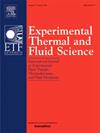Effects of employing supplemental oxygen in the ignition process on the initiation of rotating detonations
IF 2.8
2区 工程技术
Q2 ENGINEERING, MECHANICAL
Experimental Thermal and Fluid Science
Pub Date : 2024-12-12
DOI:10.1016/j.expthermflusci.2024.111389
引用次数: 0
Abstract
To simplify the ignition system, a new method named the spark plug ignition with supplemental oxygen has been proposed and validated in this study. The effects of this new ignition method on the initiation process and propagation characteristics of rotating detonations have been experimentally investigated in a hollow chamber by varying the air mass flow rate, the equivalence ratio, and the mass flow rate of supplemental oxygen. The room temperature air and ethylene are utilized as oxidizer and fuel, respectively. The experimental results indicate that rotating detonation waves can be obtained by adopting this new method under different inflow conditions, and the equivalence ratios for the detonation mode range from 0.51 to 1.15. When the equivalence ratio exceeds 0.5, the operating range and initiation time of rotating detonations achieved with this new method are comparable to those obtained with pre-detonation tube ignition. In contrast to the ordinary spark plug ignition, this new ignition method demonstrates superior performance. In addition, when additional supplemental ethylene is supplied, rotating detonations also can be obtained at the equivalence ratio of lower than 0.5 by using this new method. Moreover, increasing the mass flow rate of the supplemental oxygen is helpful for rapid establishment of rotating detonations and meanwhile, improves the success rate of initiating rotating detonations.
求助全文
约1分钟内获得全文
求助全文
来源期刊

Experimental Thermal and Fluid Science
工程技术-工程:机械
CiteScore
6.70
自引率
3.10%
发文量
159
审稿时长
34 days
期刊介绍:
Experimental Thermal and Fluid Science provides a forum for research emphasizing experimental work that enhances fundamental understanding of heat transfer, thermodynamics, and fluid mechanics. In addition to the principal areas of research, the journal covers research results in related fields, including combined heat and mass transfer, flows with phase transition, micro- and nano-scale systems, multiphase flow, combustion, radiative transfer, porous media, cryogenics, turbulence, and novel experimental techniques.
 求助内容:
求助内容: 应助结果提醒方式:
应助结果提醒方式:


